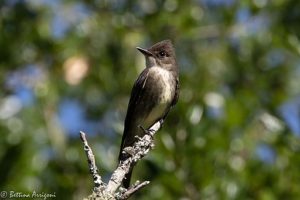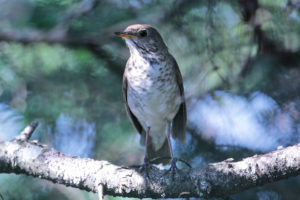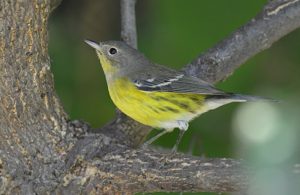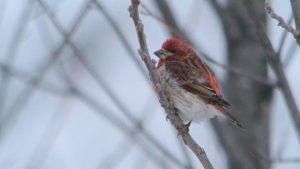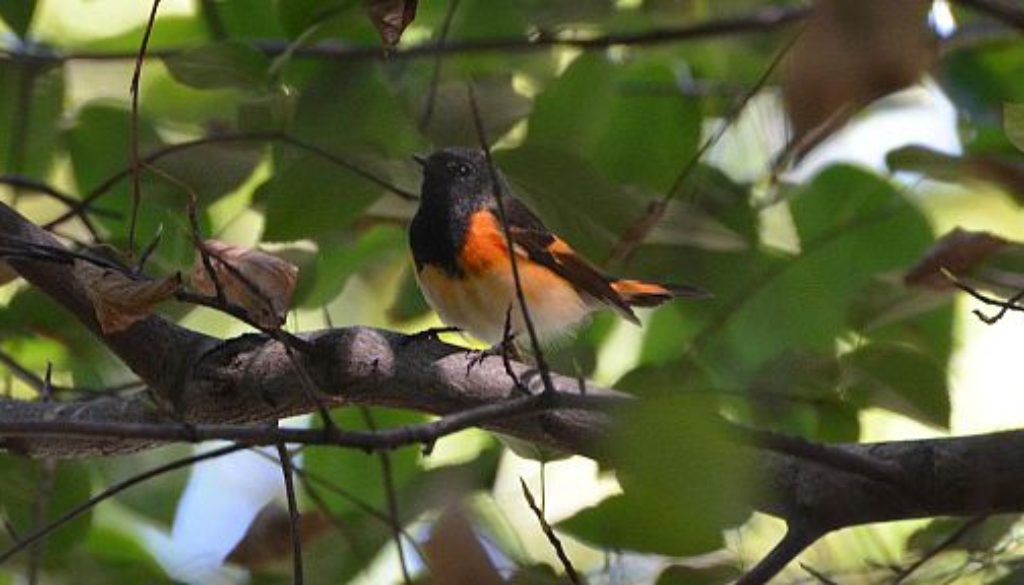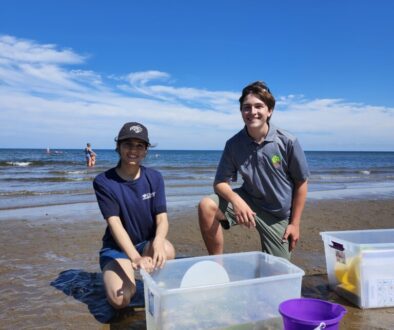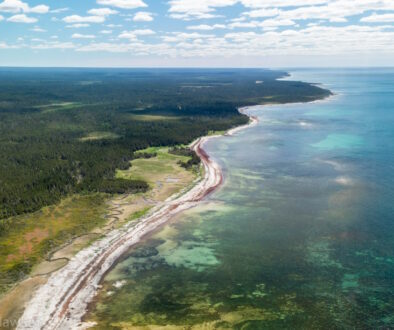Spotting New Brunswick’s forest birds this spring!
By: Heidi Harding
New Brunswick is home to hundreds of bird species, many who migrate south in the winter, then return to New Brunswick to nest and raise their young in the spring. This makes New Brunswick an amazing place for both amateur and professional birdwatchers! As our migratory friends return to their summer homes, get familiar with some of their unique traits and be prepared to keep an eye (and an ear) out for them throughout the spring and summer months!
Ruby-throated Hummingbird
The only hummingbird native to the Maritimes, the Ruby-throated Hummingbird appears in New Brunswick in mid-May and stays into September. Males have emerald green heads and backs, while females are green-grey. Both have white bellies, but only males have the iridescent ruby throats that give the species their name. These tiny birds can usually be found along the edges of woodlands, or in orchards and gardens. Sightings are increasing around humans as hummingbird feeders become more popular.
Olive-sided Flycatcher
Listed as a threatened species in Canada, the Olive-sided Flycatcher can be found in New Brunswick between May and September. Coloured mostly greys and whites, their most distinctive features are their crested heads and long wings. They prefer to live in moist forests and the edges of wetlands, bogs, and beaver ponds, and tend to perch in the highest branches they can find. The beaver pond trails at Mactaquac Provincial Park provide this kind of habitat, and offer an opportunity to see beavers, frogs, ducks, and many other species.
Bicknell’s Thrush
Bicknell’s Thrush is also a threatened species in Canada. With a small population and a very limited range, the best place to find these elusive birds is in Mount Carleton Provincial Park, where Bird Studies Canada has run surveys to learn more about this rare bird. These birds are mostly brown above and white below, with brown speckles across the throat and breast. They spend winters in the Dominican Republic then migrate north, arriving in New Brunswick in late May. They prefer young, dense forests made up of fir and spruce.
American Robin
The arrival of robins is one of the surest signs of spring, as robins are one of the most familiar and most common birds in New Brunswick! Their bright red breasts and brown backs make them quite distinct, and you can often see them hopping around lawns and fields searching for insects and worms. Robins arrive in New Brunswick as early as March and linger until November, when they head south to visit our neighbours in the United States.
Northern Parula
The Northern Parula is one of 38 species of warbler that have been recorded by our friends at Nature NB in their Birds of New Brunswick list. Grey-blue above, with yellow throats that fade to white bellies, the Northern Parula loves damp, mature forests. Old trees covered in mosses and lichens are their favourite, as they commonly use “old-man’s beard” lichen in their nests. Try Fundy National Park, Mount Carleton Provincial Park, Sugarloaf Provincial Park, or the Carriage Road hiking trail in Herring Cove Provincial Park for mossy forest environments to sight these birds. Parulas arrive in New Brunswick in May and stay until October.
Magnolia Warbler
Many warblers share similar colours with the Magnolia Warbler, with greyish backs and yellow around the throat, though the Magnolia Warbler’s yellow extends all the way down their bellies. The Magnolia Warbler is one of the most common warblers in the province, appearing in May and staying until October. They prefer to nest in younger pine forests, like those that grow up on old farmland.
American Redstart
Another common warbler in New Brunswick is the American Redstart. Like the Northern Parula and the Magnolia Warbler, Redstarts return to New Brunswick in May and stay until October. Unlike these warblers, they will happily nest in neighbourhoods with lots of taller trees and shrubs, as well as forests. Redstarts are quite distinctive among New Brunswick’s warblers, as they have a solid black head and throat, with splashes of red on their shoulders and back.
Purple Finch
Purple finches are common sights in both woodlands and neighbourhoods with bird feeders, and some will brave the winter weather to stay in New Brunswick all year round, though most prefer to migrate south in the fall, reappearing here in April or May. For a park-like setting where these smaller birds can be common, try the New Brunswick Botanical Garden in République Provincial Park. Male purple finches are easy to spot, with their bright reddish-purple heads and backs. Females are mostly brown, with brown speckles across a white breast and belly. They are fairly easy to confuse with other species of finch or sparrows. Look for a slight crest or “peak” on their heads – if its there, it’s a purple finch!
New Brunswick’s provincial parks provide important habitat for forest-loving birds and opportunities for human visitors to meet them! CPAWS-NB hopes you will take advantage of the parks to get closer to nature this spring and summer. Remember that the parks are meant for all New Brunswickers and visitors to enjoy, and that we are responsible for taking care of our environment. When you visit, be sure to take all garbage and refuse with you when you leave, keep dogs on a leash and clean up after them, and respect nature by leaving it in the park. We want all of the migratory visitors to enjoy the parks as much as we do!
All you need to begin bird-watching in New Brunswick is a pair of binoculars and a spirit ready to get outside and start your birding adventure!
Visit here for more information on New Brunswick Provincial Parks.
Resources:
Nature NB Birds of New Brunswick: An Annotated List
A full listing of birds who regularly, occasionally, and rarely visit New Brunswick. Published by The New Brunswick Museum, as a project of the New Brunswick Bird Records Committee.
New Brunswick Birdwatching Hotspots
Tourism New Brunswick’s guide to some of the best birdwatching spots and resources across the province.
Second Atlas of the Breeding Birds of the Maritime Provinces
A partnership between Bird Studies Canada, the Maritime provinces, and the Canadian Wildlife Service, this atlas documents bird who regularly breed in the Maritimes, including photos, descriptions, maps, and more.
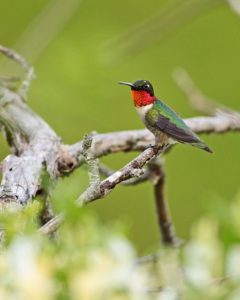
Ruby-throated Hummingbird Photo by Matt Tillett/ Wikimedia Commons/ CC-BY-2.0
